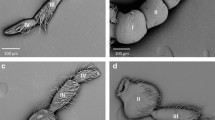Summary
Olfactory trichoid hairs on the antennae of male Antheraea silkmoths were reconstructed with respect to the following parameters: number, shape, course, and dimensions of outer dendritic segments as well as the numbers of their microtubules; inner and outer dimensions of the cuticular hair shafts; and number and distribution of pores and pore tubules in the hair walls. The smallest distances between dendritic membranes and inner hair surfaces were determined with respect to the possibility of pore tubule contacts. It was shown that most hairs contain one thick and one, or frequently two, thin dendrites. The number of microtubules in the dendrites is correlated with dendrite diameter, which decreases towards the hair tip. The dendrites form numerous swellings and constrictions: this “beading” occurs especially along the thin dendrites. The dendrites do not run straight, but rather follow a sinuous course in the hairs. The density of wall pores is lowest in the basal region of the hairs. Only in relatively few places do the dendritic membranes get near enough the hair walls to come into the probable range of the pore tubules. In the sensilla trichodea of A. polyphemus, the hairs as well as the dendrites have markedly smaller diameters than in A. pernyi.
Similar content being viewed by others
References
Adam G, Delbrück M (1968) Reduction of dimensionality in biological diffusion processes. In: Rich A, Davidson N (eds) Structural chemistry and molecular biology: A volume dedicated to Linus Pauling by his students, colleagues, and friends. Freeman, San Francisco London, pp 198–215
Boeckh J, Kaissling K-E, Schneider D (1960) Sensillen und Bau der Antennengeißel von Telea polyphemus (Vergleiche mit weiteren Saturniden: Antheraea, Platysamia und Philosamia). Zool Jahrb Abt Anat Ontog Tiere 78:559–584
De Kramer JJ, Kaissling K-E, Keil T (1984) Passive electrical properties of insect olfactory sensilla may produce the biphasic shape of spikes. Chem Senses 8(3) (in press)
Ernst K-D (1969) Die Feinstruktur von Riechsensillen auf der Antenne des Aaskäfers Necrophorus (Coleoptera). Z Zellforsch Mikrosk Anat 94:72–102
Frisch D, Everingham JW (1972) Fine structure of crab olfactory cilia: Non-chemical fixation; environmental effects. Olfaction and Taste IV:5–11
Ghiradella HT, Case JF, Cronshaw J (1968) Structure of aesthetascs in selected marine and terrestrial decapods: Chemoreceptor morphology and environment. Am Zoologist 8:603–621
Gnatzy W, Mohren W, Steinbrecht RA (1984) Pheromone receptors of Bombyx mori and Antheraea pernyi: II. Morphometric data. Cell Tissue Res 235:35–42
Kaissling K-E (1971) Insect olfaction. In: Beidler LM (ed) Handbook of sensory physiology, Vol. IV: Chemical senses, part 1: Olfaction. Springer. Berlin Heidelberg New York, pp 351–431
Kaissling K-E (1979) Recognition of pheromones by moths, especially in saturniids and Bombyx mori. In: Ritter FJ (ed) Chemical ecology: Odour communication in animals. Elsevier, Amsterdam New York Oxford, pp 43–56
Kaissling K-E, Priesner E (1970) Die Riechschwelle des Seidenspinners. Naturwissenschaften 57:23–28
Kaissling K-E, Thorson J (1980) Insect olfactory sensilla: Structural, chemical and electrical aspects of the functional organization. In: Sattelle DB, Hall LM, Hildebrand JG (eds) Receptors for neurotransmitters, hormones and pheromones in insects. Elsevier, Amsterdam New York Oxford, pp 261–282
Keil TA (1982) Contacts of pore tubules and sensory dendrites in antennal chemosensilla of a silkmoth: Demonstration of a possible pathway for olfactory molecules. Tissue Cell 14:451–462
Keil TA, Steinbrecht RA (1984) Mechanosensitive and olfactory sensilla of insects. In: King RC, Akai H (eds) Insect Ultrastructure Vol. II. Plenum Press, New York (in press)
Klein U (1980) Investigations of proteins from isolated insect olfactory hairs. Olfaction and Taste VII:89
Ochs S (1963) Beading phenomena of mammalian myelinated nerve fibers. Science 139:599–600
Sasaki S, Stevens JK, Bodick N (1983) Serial reconstruction of microtubular arrays within dendrites of the cat retinal ganglion cell: The cytoskeleton of a vertebrate dendrite. Brain Res 259:193–206
Slifer EH, Sekhon SS (1969) Nodes on insect sensory dendrites. Ann Proc EMSA 27
Slifer EH, Sekhon SS (1974) Sense organs on the antennae of two species of thrips (Thysanoptera, Insecta). J Morphol 143:445–456
Steinbrecht RA (1970) Zur Morphometrie der Antenne des Seidenspinners, Bombyx mori L.: Zahl und Verteilung der Riechsensillen (Insecta, Lepidoptera). Z Morphol Tiere 68:93–126
Steinbrecht RA (1973) Der Feinbau olfaktorischer Sensillen des Seidenspinners (Insecta, Lepidoptera). Rezeptorfortsätze und reizleitender Apparat. Z Zellforsch 139:533–565
Steinbrecht RA (1980) Cryofixation without cryoprotectants. Freeze substitution and freeze etching of an insect olfactory receptor. Tissue Cell 12:73–100
Steinbrecht RA (1982) Experiments on freezing damage with freeze substitution using moth antennae as test objects. J Microscopy 125:187–192
Steinbrecht RA, Müller B (1971) On the stimulus conducting structures in insect olfactory receptors. Z Zellforsch 117:570–575
Steinbrecht RA, Kasang G (1972) Capture and conveyance of odour molecules in an insect olfactory receptor. Olfaction and Taste IV:193–199
Steinbrecht RA, Gnatzy W (1984) Pheromone receptors of Bombyx mori and Antheraea pernyi: I. Reconstruction of the cellular organization of the sensilla trichodea. Cell Tissue Res 235:25–34
Vogt RG, Riddiford LM (1981) Pheromone binding and inactivation by moth antennae. Nature 393:161–163
Author information
Authors and Affiliations
Rights and permissions
About this article
Cite this article
Keil, T.A. Reconstruction and morphometry of silkmoth olfactory hairs: A comparative study of sensilla trichodea on the antennae of male Antheraea polyphemus and Antheraea pernyi (Insecta, Lepidoptera). Zoomorphology 104, 147–156 (1984). https://doi.org/10.1007/BF00312133
Received:
Issue Date:
DOI: https://doi.org/10.1007/BF00312133




